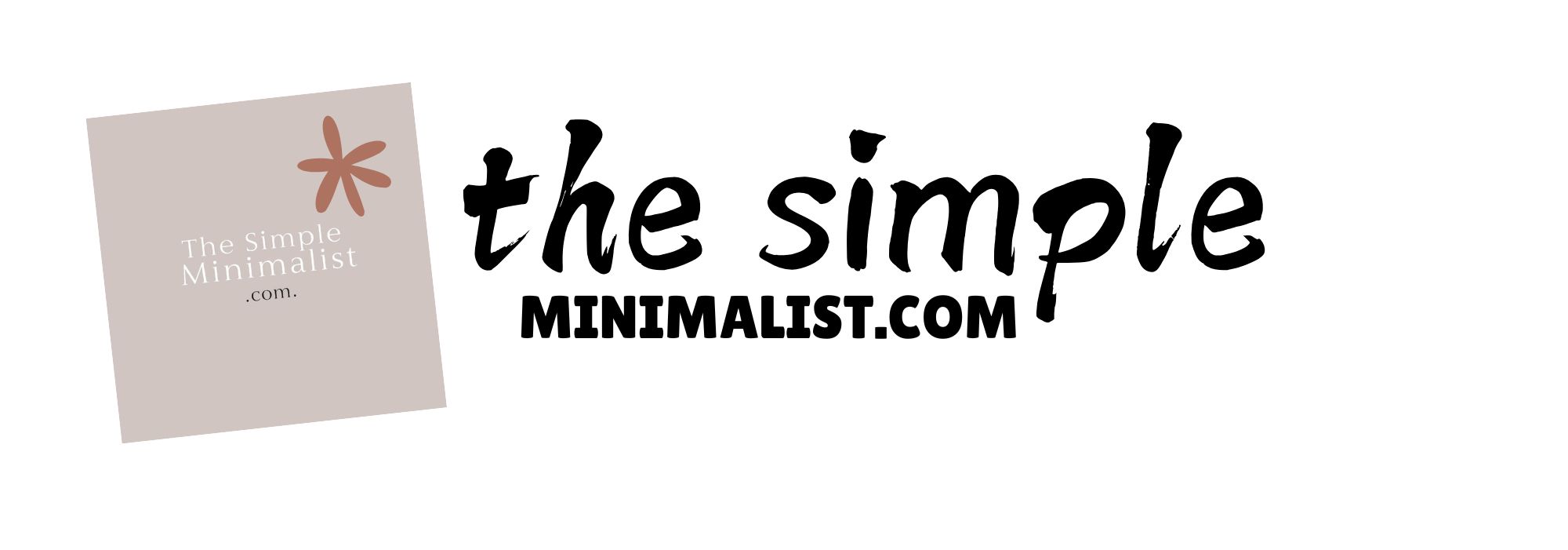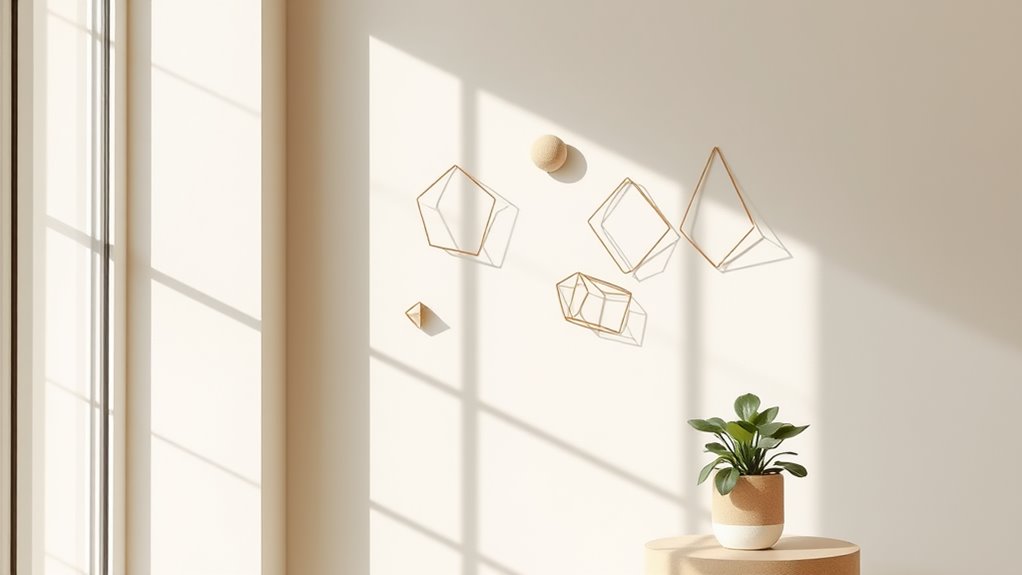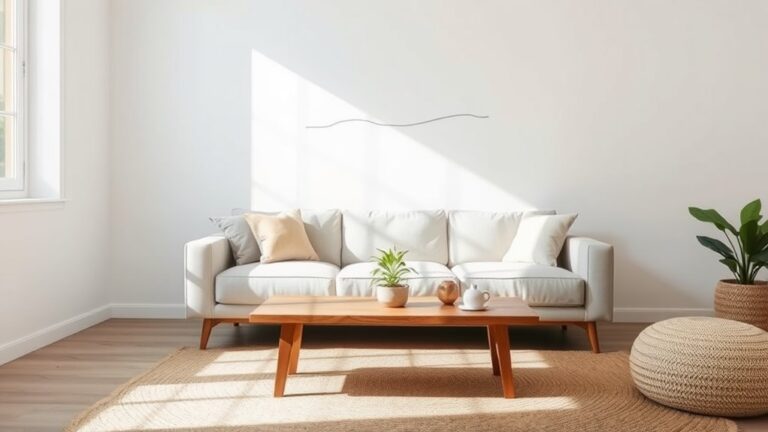If you're looking to refresh your walls, DIY minimalist art installations are a fantastic way to elevate your space! I love how simple designs, like geometric shapes, can create a sense of harmony. Choose materials that feel good—like soft pastels or natural elements—to brighten your home. Layering textures adds depth and character. It's all about balance and personalization. Want to know how to arrange your art for maximum impact? Let's explore that further!
Minimalist Highlights
- Choose sustainable, high-quality materials like canvas and fabric to create a clean and inviting foundation for your art installations.
- Embrace simple geometric shapes and monochromatic color palettes to enhance visual impact and maintain harmony in your space.
- Utilize layering techniques with textures such as string and modeling paste to add depth and interest to your minimalist wall art.
- Experiment with art arrangement by mixing various sizes and shapes while ensuring consistent spacing for a polished look.
- Personalize your creations with meaningful colors and symbols to reflect your individual style and enhance the overall aesthetic.
Understanding Minimalism in Art
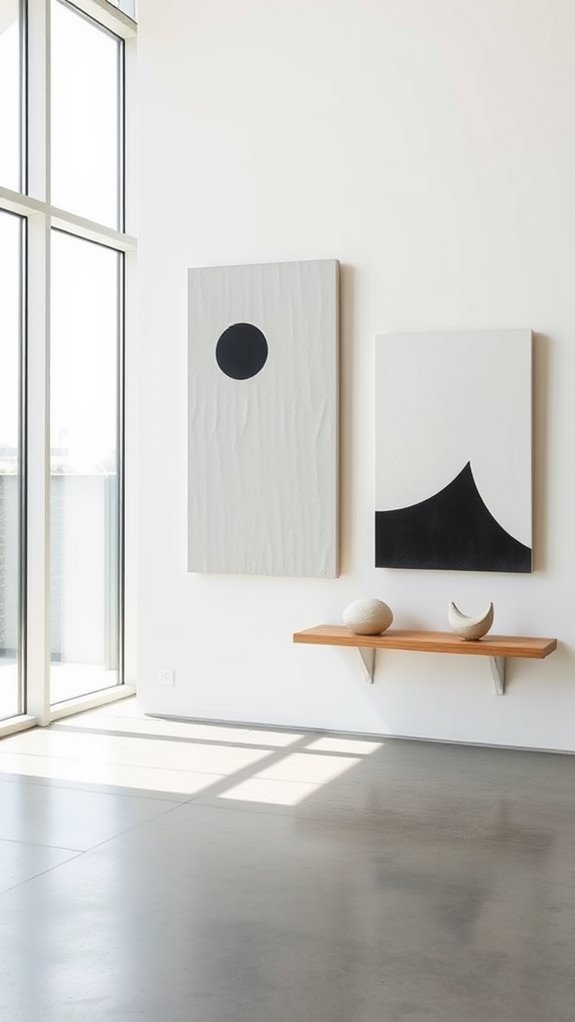
When you step into the world of minimalist art, you might find yourself captivated by its simplicity and elegance. This artistic philosophy focuses on stripping away the non-essential, allowing the beauty of form and color to shine. Minimalist decor often emphasizes clean lines and a limited color palette, which further enhances the overall aesthetic.
I've always felt that minimalist aesthetics invite us to pause and appreciate the subtle details often overlooked in our busy lives. Imagine walking into a space adorned with clean lines, muted tones, and a few carefully chosen pieces. Doesn't it make you want to breathe a little deeper?
The magic lies in the less-is-more approach, creating harmony and balance. Each piece encourages reflection, urging us to connect with the art—and ourselves—in a more profound way. Embracing minimalist decor can transform your living space into a serene sanctuary, enhancing your overall well-being. This style promotes a sense of tranquility, allowing you to focus on what truly matters in your life.
Choosing the Right Materials
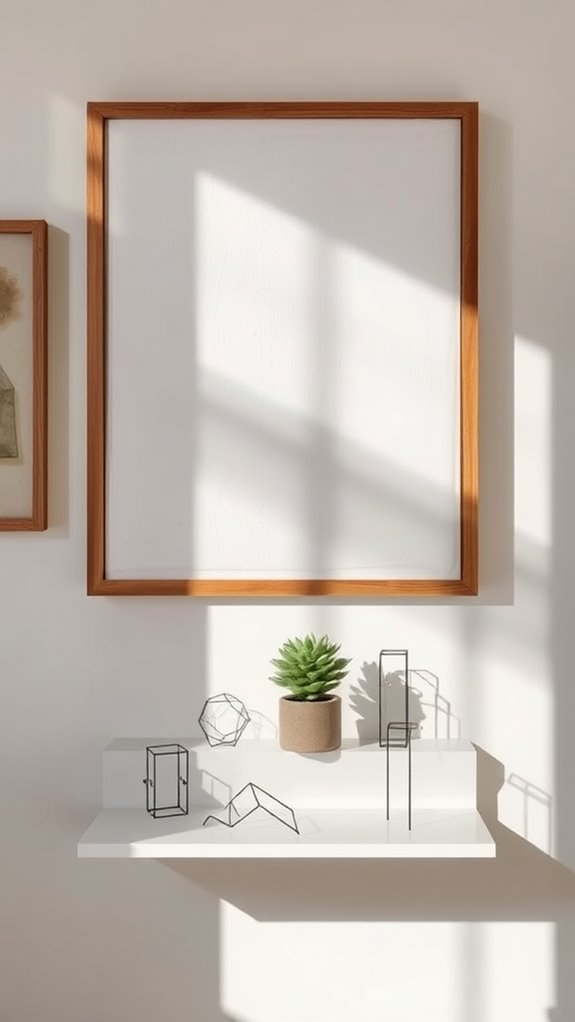
As you immerse yourself in creating your minimalist art installation, picking the right materials can make all the difference.
Your material selection sets the tone and message of your art, so why not choose wisely? I love exploring sustainable options that not only look great but also benefit the planet. Incorporating high-quality materials can enhance the longevity and overall aesthetic of your installations. For instance, utilizing soft pastel hues can brighten your artwork and create a cohesive look that resonates throughout your space. Consider incorporating metal and polyester for durability, which also complements a minimalist aesthetic. Additionally, opting for lightweight materials can further enhance the airy feel of your installations.
Choosing the right materials shapes your art's essence—opt for sustainable choices that enhance both beauty and the planet.
Consider these ideas when selecting materials:
- Recycled paper or cardboard for texture
- Natural wood for warmth
- Fabric scraps for soft, inviting elements
- Eco-friendly paints for vibrant colors. Incorporating eco-friendly options into your materials not only enhances the aesthetic but also promotes sustainable living.
Simple Geometric Shapes: A Classic Approach

Geometric shapes have a timeless appeal that can transform any space into a minimalist masterpiece. I love using simple geometric patterns in my art installations because they create a sense of order and harmony. Think about how circles, triangles, and squares can interact with one another. By applying color theory, you can enhance these shapes, drawing attention to their beauty. Imagine a bold red triangle against a soft blue background, or a series of overlapping circles in varying shades of green. These choices can evoke emotions, making your space feel inviting and inspiring. Additionally, incorporating seasonal accent pieces can complement your geometric designs, enhancing the overall aesthetic of your space. Remember, minimalist decor emphasizes simplicity, allowing these shapes to stand out even more. Furthermore, using high-quality materials in your installations ensures durability and adds to the overall aesthetic appeal. Embracing minimalist design principles can further elevate your art, ensuring that each piece serves a purpose while contributing to the overall harmony of your decor. Consider using lightweight wall art to create a focal point that enhances the visual appeal of your space.
Monochromatic Color Palettes

Although many people think of color as a way to add excitement to their art, there's something truly enchanting about using a monochromatic color palette.
By focusing on just one hue, you can create a stunning visual impact that feels both calming and cohesive. It's all about embracing color theory to achieve that perfect design balance. Incorporating soft pastels can evoke feelings of renewal, enhancing the overall aesthetic of your minimalist decor. Additionally, utilizing minimalist decor essentials can provide a curated touch that complements your monochromatic artwork. This approach aligns with the principle of maintaining a minimalist aesthetic, which emphasizes simplicity and intention in design.
Focusing on a single hue can yield a mesmerizing visual effect that embodies tranquility and unity.
One way to enhance this aesthetic is by incorporating natural materials that add warmth and texture to your space.
Here are some benefits of using a monochromatic palette:
- Simplicity: Keeps your art uncluttered and elegant.
- Focus: Draws attention to shapes and textures.
- Harmony: Creates a serene atmosphere in your space.
- Versatility: Easily adapts to different styles and rooms.
- Incorporating a limited color palette can enhance the overall aesthetic of your minimalist decor.
Creating Textured Wall Art

Creating textured wall art is one of my favorite ways to bring life to a space, and it's easier than you might think! With just a few materials and some layering techniques, you can craft a piece that not only looks stunning but also feels inviting.
Have you ever thought about how a unique texture can transform a simple wall into a conversation starter? Incorporating minimalist decor essentials can elevate the overall aesthetic of your space while maintaining a clean and organized environment. Additionally, using natural materials in your art can enhance the organic feel of your decor and further simplify your design approach. The beauty of minimalist design lies in its ability to create a serene atmosphere that encourages mindfulness. Consider adding seasonal colors and themes to your textured wall art to create a dynamic atmosphere that evolves with the seasons. Using simple design principles can help you achieve a balanced look that complements your minimalist style.
Materials for Textured Art
When it comes to making textured wall art, the materials you choose can truly transform your vision into reality. I love exploring various textured materials that not only add depth but also bring a unique flair to my creations. Understanding color theory helps me pick the right hues to complement these textures. Here are some materials I've found particularly inspiring:
- Canvas: It serves as a perfect base for layering.
- Fabric: Different textures can create stunning visual contrasts.
- Modeling paste: This medium adds a three-dimensional aspect.
- Natural elements: Think wood, stones, or leaves for an organic touch. Incorporating minimalist decor essentials can help maintain a clean and cohesive look throughout your space, allowing the textures to truly shine. Additionally, minimalist design principles emphasize simplicity, which can enhance the overall aesthetic of your textured art pieces. Experimenting with these can ignite your creativity and lead to a piece that resonates with your personal style. Furthermore, utilizing minimalist decor can create a harmonious environment that enhances your art. Additionally, incorporating neutral color palettes can enhance the overall aesthetic of your textured art pieces. What textures speak to you?
Techniques for Layering Texture
Layering texture is a magical process that can elevate your wall art to new heights. Using different layering techniques, I create stunning texture contrast that captivates the eye. Think about the feeling you want to evoke; a mix of rough and smooth surfaces can add depth and interest. Here's how I visualize my projects:
| Layer Type | Material | Texture Effect |
|---|---|---|
| Base Layer | Canvas | Soft, inviting |
| Middle Layer | String | Rustic, dynamic |
| Top Layer | Paint | Sleek, glossy |
| Final Touch | Sand or beads | Textured, playful |
Incorporating minimalist decor into your art can enhance the overall aesthetic of your space. By embracing simplicity in design, you can create pieces that not only resonate but also align perfectly with your decor theme. Using minimalist principles can guide you in selecting materials that reflect clarity and intention. Additionally, consider the color palette choices that can evoke a calming atmosphere in your art. Remember that minimalist home decor essentials can help streamline your artistic process and keep your focus on impactful simplicity.
Displaying Your Creation
There's something truly special about transforming your living space with textured wall art. Minimalist decor emphasizes simplicity and functionality, allowing your art to take center stage. Incorporating minimalist design principles can further elevate your art's impact.
When displaying your creation, consider important factors like display height and wall placement to guarantee it shines. I love experimenting with different arrangements that reflect my personality.
Here are some tips to guide you:
- Hang the art at eye level for maximum impact.
- Create a gallery wall by mixing shapes and sizes.
- Use natural light to highlight the textures.
- Consider the surrounding décor to create harmony.
Additionally, embracing minimalist decor can enhance the overall aesthetic of your space.
Incorporating Natural Elements

Incorporating natural elements into your minimalist art installations can transform a simple idea into something truly enchanting.
I love using nature-inspired designs as they bring warmth and a sense of serenity to my space. Think about including organic materials like wood, stone, or even dried flowers.
Nature-inspired designs infuse warmth and serenity, making organic materials like wood, stone, and dried flowers essential for a calming space.
These elements not only add texture but also create a connection to the outdoors. You might consider creating a wall hanging with twigs and string or framing pressed leaves for a unique touch.
Each piece tells a story and invites a sense of calm. As you explore these ideas, ask yourself: how can nature inspire your creativity?
Embrace the beauty around you and let it breathe life into your walls!
Using Negative Space Effectively
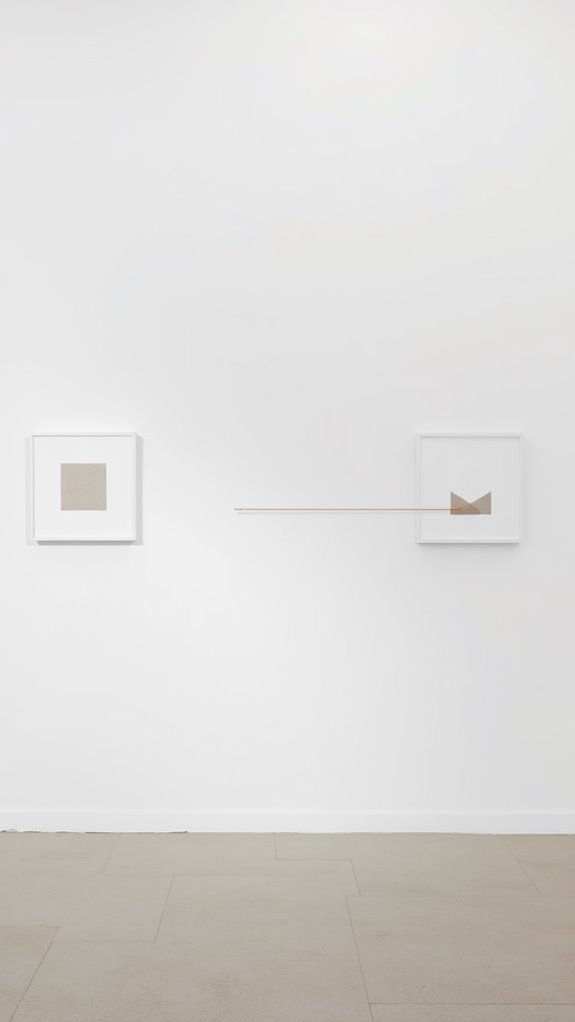
How can we transform emptiness into beauty? Embracing negative space can do just that, creating a harmonious artistic balance in our homes.
It's not just about filling every corner; it's about letting the spaces breathe. Here are some ways to make the most of negative space:
- Choose a single, striking piece as a focal point.
- Arrange smaller artworks with plenty of breathing room.
- Use light colors to enhance the feeling of openness.
- Incorporate natural elements to connect with the surroundings.
DIY Wall Hanging Techniques

When I think about DIY wall hanging techniques, macramé and textile art come to mind as perfect ways to add character to any space.
Have you ever tried knotting some cords together or repurposing old fabrics into a stunning piece?
It's amazing how a few simple materials can transform your walls and showcase your creativity!
Macramé Wall Hangings
There's something truly special about macramé wall hangings that can transform a simple space into a cozy haven.
The intricate patterns created by macramé knots bring warmth and texture to my walls, enhancing the overall wall aesthetics. Plus, they're surprisingly easy to make!
Here's what you'll need to get started:
- Cotton or jute cord
- A wooden dowel or branch
- Scissors
- A measuring tape
As I work on my designs, I love experimenting with different knot techniques. Each piece feels unique and adds a personal touch to my home.
Have you tried making one yet? There's a certain joy in crafting something beautiful with your own hands, and I can't wait for you to experience it too!
Fabric and Textile Art
As I plunge into the world of fabric and textile art, I find that it offers endless possibilities for creating stunning wall hangings that breathe life into any room.
I love experimenting with various fabric patterns—floral, geometric, or even abstract designs can add depth and character to my space.
Using simple textile techniques like weaving, layering, or even sewing patches together, I can craft unique pieces that reflect my personality.
Have you ever thought about how a wall hanging could change the vibe of your home?
Whether it's a cozy macramé or a vibrant fabric collage, the only limit is your imagination.
Arranging Your Art for Maximum Impact
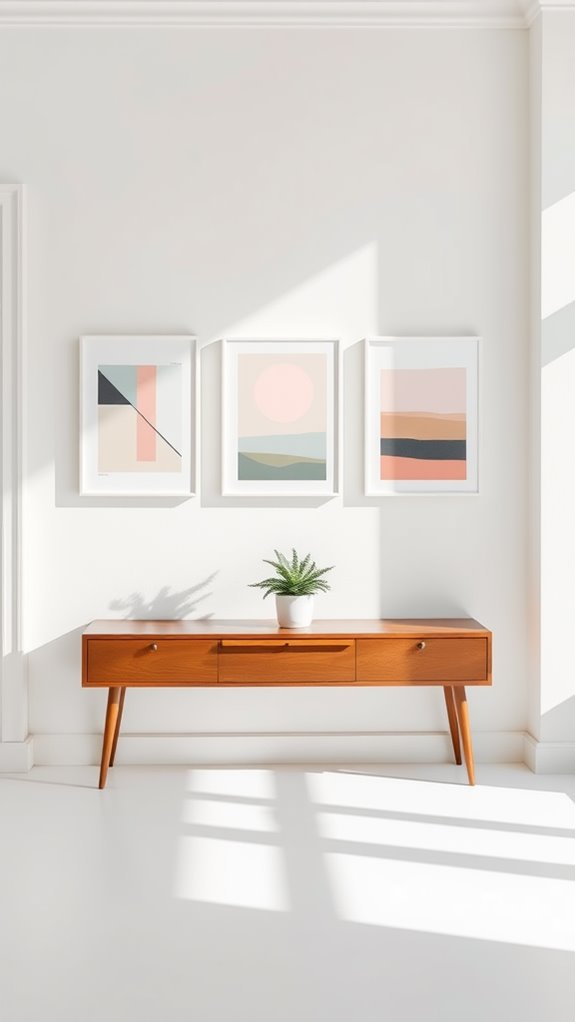
Arranging your art can feel like piecing together a puzzle, and the right setup can truly transform your space.
Arranging art is like solving a delightful puzzle; the perfect setup can elevate your entire space.
When I'm deciding on art placement, I focus on creating visual balance. Here are a few tips that help me achieve that perfect arrangement:
- Choose a focal point that draws the eye.
- Vary the sizes of your art pieces to create interest.
- Keep spacing consistent for a clean look.
- Experiment with different layouts before committing.
As you arrange your art, don't be afraid to play around!
Step back and see how the pieces interact. With a little patience and creativity, you'll find a setup that not only enhances your wall but also reflects your personal style.
Happy decorating!
Personalizing Your Minimalist Creations

While creating minimalist art, I often find that adding personal touches makes a world of difference. Custom symbolism can elevate your pieces, turning them into reflections of your own experiences.
For instance, I love incorporating colors that resonate with my favorite memories or shapes that represent significant moments in my life. These elements weave personal narratives into my work, making it uniquely mine.
Have you considered what stories your art could tell? Think about what inspires you, then let that guide your choices. You might start with a simple line or a specific color palette that holds meaning for you.
Frequently Asked Questions
What Is the History of Minimalist Art?
The history of minimalist art fascinates me!
Emerging in the late 1950s, this art movement focused on simplicity and purity, emphasizing design principles like form and color over complexity.
Artists wanted viewers to engage with the artwork on a deeper level, stripping away distractions.
Doesn't it feel invigorating?
I love how minimalist art invites us to appreciate the beauty in simplicity, encouraging us to see the world from a new perspective.
What do you think?
How Can I Maintain My Minimalist Art Installations?
Maintaining your art installations is easier than you think!
I always start with regular dusting; a soft cloth works wonders. For more stubborn grime, a gentle cleanser does the trick.
I also check my installation techniques—ensuring they're secure helps prevent damage. If a piece needs a refresh, I love experimenting with new arrangements.
How do you keep your art looking fresh? Let's celebrate our creativity and keep those walls inspiring together!
Are There Any Common Mistakes to Avoid?
We've all seen art that's just a bit off, right?
One common mistake I've made is losing artistic balance. Too many pieces can crowd a space, while too few can feel empty.
Also, remember color harmony; it's essential! Choosing shades that clash can distract instead of inspire.
Where Can I Find Inspiration for My Designs?
If you're looking for inspiration for your designs, I've found a few great places!
Check out design trends on platforms like Pinterest or Instagram; they're full of fresh art styles to spark your creativity.
Don't forget to visit local galleries or art fairs, too! Seeing art in person really energizes my ideas.
What catches your eye?
Remember, blending different styles can lead to something truly unique.
Let's get inspired together!
How Do I Choose the Right Wall for My Artwork?
When it comes to choosing the right wall for your artwork, it's like finding a needle in a haystack!
I always consider wall size first—too big or too small can throw off the balance.
Then, I think about color contrast. A bold piece pops against a neutral wall, while softer hues create harmony.
Take a step back and visualize how it all fits together. Trust your instincts; you'll find the perfect spot!
Conclusion
As you begin your journey to refresh your walls, remember that minimalist art isn't just about simplicity; it's a canvas for your thoughts and feelings. Each piece you create is like a new lease on life, inviting peace and clarity into your space. So, gather your materials, explore your creativity, and let your walls tell your story. Are you ready to transform your home into a reflection of who you are? Let's make it happen!
